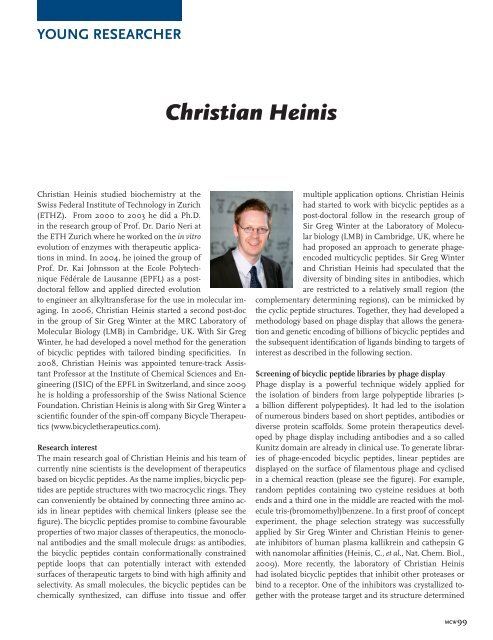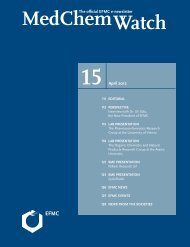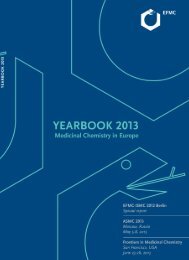You also want an ePaper? Increase the reach of your titles
YUMPU automatically turns print PDFs into web optimized ePapers that Google loves.
YOUNG RESEARCHER<br />
Christian Heinis studied bio<strong>chem</strong>istry at the<br />
Swiss Federal Institute of Technology in Zurich<br />
(ETHZ). From 2000 to 2003 he did a Ph.D.<br />
in the research group of Prof. Dr. Dario Neri at<br />
the ETH Zurich where he worked on the in vitro<br />
evolution of enzymes with therapeutic applications<br />
in mind. In 2004, he joined the group of<br />
Prof. Dr. Kai Johnsson at the Ecole Polytechnique<br />
Fédérale de Lausanne (EPFL) as a postdoctoral<br />
fellow and applied directed evolution<br />
to engineer an alkyltransferase for the use in molecular imaging.<br />
In 2006, Christian Heinis started a second post-doc<br />
in the group of Sir Greg Winter at the MRC Laboratory of<br />
Molecular Biology (LMB) in Cambridge, UK. With Sir Greg<br />
Winter, he had developed a novel method for the generation<br />
of bicyclic peptides with tailored binding specificities. In<br />
2008, Christian Heinis was appointed tenure-track Assistant<br />
Professor at the Institute of Chemical Sciences and Engineering<br />
(ISIC) of the EPFL in Switzerland, and since 2009<br />
he is holding a professorship of the Swiss National Science<br />
Foundation. Christian Heinis is along with Sir Greg Winter a<br />
scientific founder of the spin-off company Bicycle Therapeutics<br />
(www.bicycletherapeutics.com).<br />
Research interest<br />
The main research goal of Christian Heinis and his team of<br />
currently nine scientists is the development of therapeutics<br />
based on bicyclic peptides. As the name implies, bicyclic peptides<br />
are peptide structures with two macrocyclic rings. They<br />
can conveniently be obtained by connecting three amino acids<br />
in linear peptides with <strong>chem</strong>ical linkers (please see the<br />
figure). The bicyclic peptides promise to combine favourable<br />
properties of two major classes of therapeutics, the monoclonal<br />
antibodies and the small molecule drugs: as antibodies,<br />
the bicyclic peptides contain conformationally constrained<br />
peptide loops that can potentially interact with extended<br />
surfaces of therapeutic targets to bind with high affinity and<br />
selectivity. As small molecules, the bicyclic peptides can be<br />
<strong>chem</strong>ically synthesized, can diffuse into tissue and offer<br />
Christian Heinis<br />
multiple application options. Christian Heinis<br />
had started to work with bicyclic peptides as a<br />
post-doctoral follow in the research group of<br />
Sir Greg Winter at the Laboratory of Molecular<br />
biology (LMB) in Cambridge, UK, where he<br />
had proposed an approach to generate phageencoded<br />
multicyclic peptides. Sir Greg Winter<br />
and Christian Heinis had speculated that the<br />
diversity of binding sites in antibodies, which<br />
are restricted to a relatively small region (the<br />
complementary determining regions), can be mimicked by<br />
the cyclic peptide structures. Together, they had developed a<br />
methodology based on phage display that allows the generation<br />
and genetic encoding of billions of bicyclic peptides and<br />
the subsequent identification of ligands binding to targets of<br />
interest as described in the following section.<br />
Screening of bicyclic peptide libraries by phage display<br />
Phage display is a powerful technique widely applied for<br />
the isolation of binders from large polypeptide libraries (><br />
a billion different polypeptides). It had led to the isolation<br />
of numerous binders based on short peptides, antibodies or<br />
diverse protein scaffolds. Some protein therapeutics developed<br />
by phage display including antibodies and a so called<br />
Kunitz domain are already in clinical use. To generate libraries<br />
of phage-encoded bicyclic peptides, linear peptides are<br />
displayed on the surface of filamentous phage and cyclised<br />
in a <strong>chem</strong>ical reaction (please see the figure). For example,<br />
random peptides containing two cysteine residues at both<br />
ends and a third one in the middle are reacted with the molecule<br />
tris-(bromomethyl)benzene. In a first proof of concept<br />
experiment, the phage selection strategy was successfully<br />
applied by Sir Greg Winter and Christian Heinis to generate<br />
inhibitors of human plasma kallikrein and cathepsin G<br />
with nanomolar affinities (Heinis, C., et al., Nat. Chem. Biol.,<br />
2009). More recently, the laboratory of Christian Heinis<br />
had isolated bicyclic peptides that inhibit other proteases or<br />
bind to a receptor. One of the inhibitors was crystallized together<br />
with the protease target and its structure determined<br />
MCW99





